“Let me here say a word to the Jews. We do not want you to believe our doctrine. If any professing to be Jews do so, it would prove they were not Jews. A Jew cannot now believe in Jesus Christ. The decree has gone forth from the Almighty that they cannot have the benefit of the atonement until they gather to Jerusalem, for they said, ‘Let his blood be upon us and our children.’”
So said the prophet Brigham Young in 1866.[1]

The quote Young attributes to the Jews—“Let his blood be upon us …”—refers to an exchange between Pontius Pilate and a group of people gathered at his palace in Jerusalem. As you will recall, Christ had come to town for the annual Passover festival. While there, he was taken prisoner in the middle of the night and made to stand trial for blasphemy, a capital offense under Jewish law. After the Sanhedrin Council found him guilty, they took him to Pontius Pilate to be executed since Rome did not allow the Jews to impose the death penalty. [2]
Pilate, after interrogating Christ, concluded that he violated no law but knew he would incur the displeasure of the Chief Priests if he simply let Jesus go. So he devised a plan. He gave the chief priests and their sycophants a choice: “There’s this bad dude called Barabbas who we are planning to dispatch to the next life so he won’t trouble the community anymore. Or, if you prefer, I can put Jesus to death, though, as far as I can tell, he has never harmed anyone and seems like a nice fellow; so, what’s your preference?”[3] Old Pontius thought this would be a slam dunk; alas…

As we all know, the crowd said, “Let Barabbas go and we’ll rehabilitate him with our new twelve-step program.” Pilate, quite perplexed, then asks, “What should I do with Jesus who is called the Messiah?” In unison, everyone shouts, “Let him be crucified!” And let “his blood be on us and on our children.”[4]
“Jewish decide” is the belief that all Jews since the time of Jesus through the present day are collectively responsible for the killing of Christ.[5] Brigham Young, along with several of his successors well into the second half of the 20th century—e.g., James E. Talmage,[6] Joseph Fielding Smith,[7] Bruce R. McConkie[8]—have not only embraced this doctrine but some have extended it beyond the temporal world in order to subordinate the spiritual opportunities of the Jews in afterlife. As Young put it, their lineage is cursed.[9]
The Book of Mormon lends credence to Young’s position. Jesus came to the Jews, according to Second Nephi, because they were the only nation wicked enough to crucify him.[10] Other passages of this sacred text attribute the death and destruction visited upon the Jews over time to their wickedness.[11] Hence, the Lord gave the gentiles the power to scatter the Jews.[12] Revelations given to Joseph Smith, as recorded in the Doctrine & Covenants, express similar sentiments.[13]
There are several passages in the Book Mormon where God is quoted as expressing his love and affection for the Jewish people and his intention to hold gentiles accountable for persecuting the Jews. But even some of those scriptures seem to condone past persecutions.[14] Given Joseph Smith’s familiarity with the King James Bible and how, in the words of one author, “the Book of Mormon Reads, and Rereads the Bible,”[15] the presence of antisemitic sentiments in the Book of Mormon should come as no surprise.
Mercifully, all of this is pure, unadulterated, horseshit.
* * * * * * * * * * * * * *
There are several reasons for questioning whether Christ was ever interrogated by Pilate and, likewise, whether he ever offered the Jews the choice of sparing the life of Barabbas or Jesus.
While Jerusalem’s population during Jesus’ life was around 30,000 – 70,000, that figure could swell to upwards of 400,000 during Jewish festivals, the largest of which was Passover.[16] Given the enmity felt by the Jews towards their occupiers, this presented a frightening challenge for the single Roman legion—about 5,000 soldiers—garrisoned in the city.
To guard against an uprising, they strictly enforced two rules: (1) unauthorized gatherings and mobs were promptly dispersed, with violence if necessary, and (2) rabble-rousers—especially those who promised freedom from the yoke of Roman tyranny—were summarily dispatched. And since the temple had been the scene of many disturbances in the past, the Romans watched it like a cast of hawks.
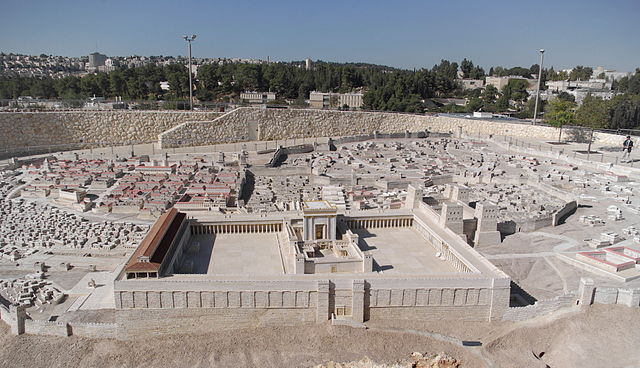
The temple area in Jerusalem at this time was about 35 acres, and most of it was open and clearly visible from the outside. At the top of three of the four surrounding walls were walkways, allowing Roman soldiers to patrol and monitor the entire area. Herod the Great constructed a large military fort on the north end—the Antonia Fortress, named for Mark Antony, his patron—so that the Roman legion could be summoned to swiftly respond to any sign of civil unrest.[17] Sure enough, during this Passover celebration a troublemaker made his presence known.
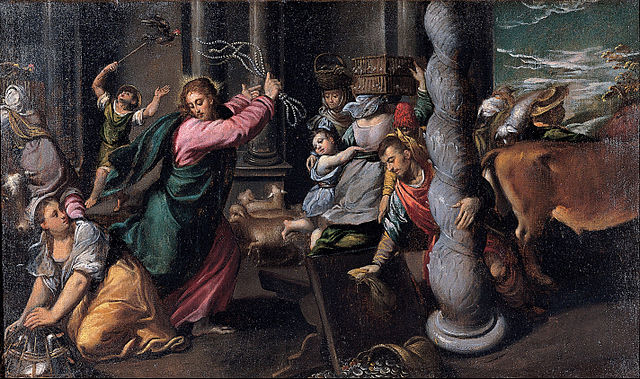
The day after his triumphal entry into Jerusalem, Christ cleansed the temple, casting “out all them that sold and bought in the temple, and overthrew the tables of the moneychangers,…,” calling them “a den of thieves.”[18] He then proceeded to heal the blind and lame, prompting the children to cry “in the temple,… Hosanna to the son of David.” In other words, the Messiah. But Jesus was not the first to claim such status.
A few of these false Messiahs are mentioned in the New Testament. In Acts we read about the prophet Theudas who achieved a following of four hundred disciples—until Rome captured and decapitated him.[19] My personal favorite is a poor shepherd named Athronges who foolishly put a ransom on his own head by crowning himself “King of the Jews;” he and his followers were massacred by a Roman legion.[20] Finally, there was a messianic aspirant known simply as “the Samaritan” who was executed by Pontius Pilate even though he had no significant following.[21] Why such intolerance on Pilate’s part? Because the first century was an era of apocalyptic expectation, a belief by the Jews that God was going to purge Palestine of the iron fist of Rome. And Pilate would have none of it.
Jesus, of course, was aware of much of this history. In other words, he was deliberately poking both the High Priests and the Romans in the eye. As we know, his provocation succeeded. Shortly thereafter, he was arrested while praying in the Garden of Gethsemane. When one of his disciples drew his sword in an attempt to prevent the Savior’s arrest, Christ stopped him saying, “how then would the Scriptures be fulfilled that say it must happen in this way?”[22]
This takes us to where we began: the “Jewish decide,” the alleged willingness of the Jews to take responsibility for the death of Jesus in exchange for Pilate agreeing to execute the man. But the credibility of this dialogue between the Roman Prefect and the people is highly suspect.
First, there is no record of the Romans ever pardoning a prisoner at Passover as a gesture of goodwill.[23] Further, the severity with which Pilate governed Judea suggest that such an act, under any circumstances, would have been totally out of character. Showing mercy was not his schtick.
Second, the area outside the Praetorium consisted of a modest courtyard that could accommodate only a small gathering. Moreover, how could the Chief Priests mobilize a pro-crucifixion crowd on such short notice—or at any time, for that matter—given Christ’s popularity among the masses, people who generally held the Jewish elite in contempt? Weren’t these the same folks who just a few hours ago seized Jesus in the dead of night because they feared a popular uprising if they arrested him in broad daylight, and who couldn’t get a single person to bear false witness against the Savior at his trial?!?[24]
Lastly, the Romans would not have countenanced a large mob, one with the clear potential to become unruly (“a riot was beginning”) should its demands go unmet.[25] Also, as one Jewish scholar amusingly observed, the notion “of a large crowd—especially a Jewish crowd!—conducting conversations in a unified, coherent voice” is absurd.[26]
None of this makes sense. So how do we explain it? We start by examining the events transpiring not at this time, but during the period when the gospels were written.
* * * * * * * * * * * * * * * * * *
Most biblical scholars believe the four gospels were written roughly between 65 and 100 A.D., with John being the last. This would have coincided with the general Jewish uprising and the destruction of both Jerusalem and its temple (66 – 70 A.D.) There ensued two concurrent political struggles in Palestine: (1) the Roman crackdown and ongoing campaign to subdue Palestine, and (2) conflicts between various Jewish factions, including the Jesus movement.[27]
The budding Christians wanted to distance themselves from the conflict with Rome, which they believed was pointless since Jesus said he would soon return to establish his kingdom on earth. The actual schism occurred with the Jewish edict of circa 85 A.D., which condemned Christians as heretics and banned them from the synagogue.[28]
What started as different sects within the same faith tradition splintered into factions and became rivals—each of whom felt they were involved in a great struggle between good and evil. This helps explain why references to “the Jews” in the Synoptic Gospels are relatively rare, but by the time we get to the Gospel of John, written around 100 A.D., the term is used more than seventy times, usually in an unflattering way.[29] Though John, among all the Evangelists, is the only one that explicitly confines the blame for Christ’s crucifixion, to the “chief priests and officers,” not the Jewish people as a whole.[30]
With this contextual understanding, biblical scholars in the 1960s began to reexamine the validity of “Jewish decide.” Their reinterpretation advanced three arguments in support of the proposition that the Jewish people, as a group, were neither responsible for, nor implicated in, Christ’s death.
First, they reminded everyone of the obvious: that almost all the principals in the life and ministry of Jesus were Jews, including his disciples and the general Judean public to whom Christ preached. Second they illustrated, through textual analysis, that the intended meaning of “the Jews” in the Old Testament referred solely to the people of those specific times and places—not all Jews everywhere.[31]
Third, and most convincingly, they demonstrated that the meaning of “the Jews” in the Gospels was usually a reference to the political and religious elite, not the people as a whole.[32] The broadening of this term to include all Jews occurred in the second and third centuries as the Gospels were edited and revised by scribes at the behest of church leaders for purposes of validating the “Jewish decide.”[33] Unsurprisingly, this has fostered Christian antisemitism and been employed to rationalize all manner of pogroms, massacres, expulsions and other acts of violence against the Jews.
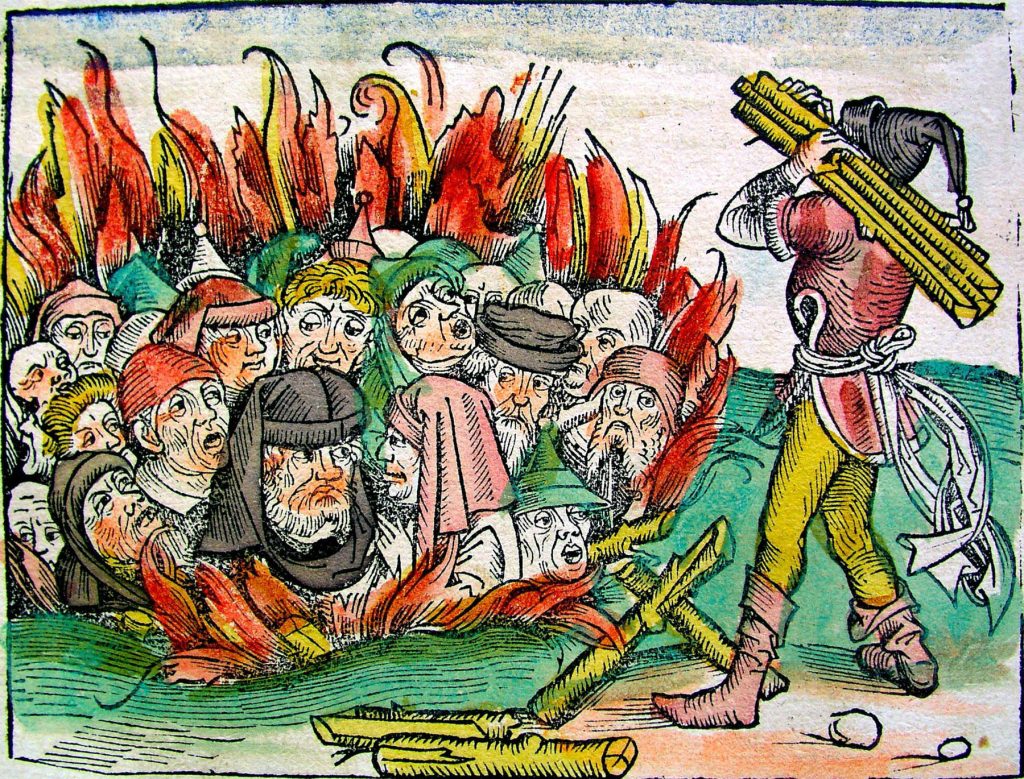

For example, in 1147 during the Easter season, participants in the Second Crusade, while enroute to the Holy Land, were incited by Christian preachers in Germany to avenge Christ’s death by killing and torturing non-Christians. As a result, many Jews were killed, maimed and beaten—unless they agreed to forced conversion. Simon of Trier was decapitated by having his head crushed in a winepress. Mistress Mina Speyer had her ears and thumbs cut off. To their everlasting credit, and as an act of great courage and integrity, some Jews committed suicide rather than enter the waters of baptism.[34]
Unsurprisingly, “Jewish decide” is alive and well today. Our society is infested with antisemitic attitudes and the plague is still spreading. Jew-hatred is running rampant in the media, our government, at universities—among both faculty and students—and is now being taught in our public schools.[35]

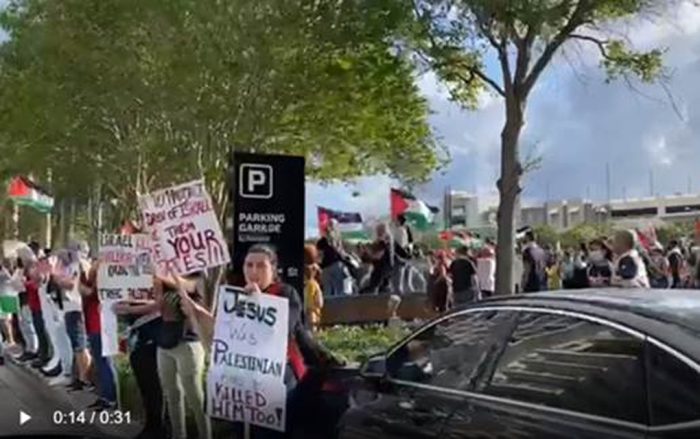
* * * * * * * * * * * * * * * * * *
Lamentably, antisemitism periodically rears its ugly head in the Mormon Church today. Six years ago, I sat in a Gospel Doctrine class on Easter Sunday where the instructor, unequivocally, said the Jews killed Jesus. When challenged, she wouldn’t back down. And a few years ago, a Jewish convert to the church was told by some members of his congregation that he killed Christ because he was born and raised Jewish. His ancestors who died in the Holocaust, they went on to say, were incarcerated, gassed and incinerated because of their lineage. This young man, somewhat to my surprise, didn’t want to leave the church. Rather, he simply wanted to know, “how I can stop being angry with these members?”[36]
These are not mere anecdotes. A rigorous analytical poll conducted by a highly-respected Mormon scholar in 2003 found that a majority of Latter-day Saints subscribe to the antisemitic belief “that Jews are still being punished by God and that Jews cannot be forgiven for their continuing perfidy until they accept Jesus Christ.” Curiously, these same people adopt a posture of “religious affinity toward Jews … based on the belief that the Jews remain a ‘chosen people’ in God’s eyes and that Mormons share with Jews a literal Israelite ancestry.”[37]
Why do a majority of Latter-day Saints subscribe to such seemingly incongruous views? The answer is simple, Mauss says: “[B]oth are part of a generally orthodox Mormon outlook.”[38] This is unacceptable.
Yes, church leaders have distanced themselves from the antisemitic beliefs of their predecessors. And their statement condemning the 2018 shootings in a Pittsburgh synagogue (which resulted in 11 fatalities and seven serious injuries) and the Jew-hatred behind this massacre was excellent.[39] But antisemitism will continue to rear its ugly head in the church unless its leaders renounce the bigoted teachings of their predecessors and abandon scriptural literalism.
Reading our sacred texts through the eyes of a 21st century westerner will invariably distort their meaning and blind us to the message and teachings Jehovah and his prophets were trying to convey. The only way to combat this is to: (a) immerse ourselves in the culture, beliefs and traditions of those who wrote these sacred texts, (b) become familiar with both the political and social dynamics of their societies, and (c) resist the temptation to apply our values and modern conventions when judging their actions and decisions.
Mine is a desperate plea for change. Because scriptural literalism literally kills.
[1] Brigham Young, “Remarks,” Journal of Discourses, Vol. 11 (Brigham Young University Press: Provo, Utah, 1964), p. 279.
[2] Matt. 26: 47-66; Matt. 27:1-2 (NRSV).
[3] Matt. 27:11-20 (NRSV)
[4] Ibid, vs. 21-25.
[5] Aldo Schiavone, Pontius Pilate: Deciphering A Memory, (Liveright Publishing Corporation: New York, New York, 2017), p. 144.
[6] James E. Talmage, Jesus the Christ, (Deseret Book Company: Salt Lake City, Utah, 1972), p. 641
[7] Joseph Fielding Smith, Selections from Doctrines of Salvation, (Deseret Book Company: Salt Lake City Utah, 2001) p. 292.
[8] Bruce R. McConkie, The Millennial Messiah, (Deseret Book Company: Salt Lake City, Utah, 1982), pp. 224-225 (“Let this fact be engraved in the eternal records with a pen of steel: the Jews were cursed, and smitten, and cursed anew, because they rejected the gospel, cast out their Messiah, and crucified their King.” * * * * “Let the spiritually illiterate suppose what they may, it was the Jewish denial and rejection of the Holy One of Israel, whom their fathers worshiped in the beauty of holiness, that has made them a hiss and a byword in all nations and that has taken millions of their fair sons and daughters to untimely graves.”
[9] Armand L. Mauss, All Abraham’s Children: Changing Mormon Conceptions of Race and Lineage, (Univesity of Illinois Press: Urbana & Chicago, Illinois, 2003), p. 171; Arnold H. Green, “Gathering and Election: Israelite Descent and Universalism in Mormon Discourse,” The Journal of Mormon History, (Vol. 25, No. 1, 1999), p. 205.
[10] 2 Nephi 10:3.
[11] 2 Nephi 25:9; 2 Nephi 10:6; Arnold H. Green (1994). “Jews in LDS Thought” (BYU Studies Quarterly. 34, 1994.
[12] 3 Nephi 20:27.
[13] D&C 45: 53; 98:17.
[14] Mormon, the Nephite prophet-historian, wrote, “Yea, and ye need not any longer hiss, nor spurn, nor make game of the Jews, nor any of the remnant of the house of Israel; for behold, the Lord remembereth his covenant unto them, and he will do unto them according to that which he hath sworn.” 3 Nephi 29:8.
[15] Micahel Austin, The Testimony of Two Nations: How the Book of Mormon Reads, and Rereads, the Bible, (Urbana, Illinois: University of Illinois Press, 2024).
[16] E. P. Sanders, The Historical Figure of Jesus, (London, England: Penguin Books, 1993), p. 249
[17] Kenneth E. Bailey, Jesus Through Middle Eastern Eyes: Cultural Studies In The Gospels, (Downers Grove, Illinois: InterVarsity Press, 2003) p. 232-233.
[18] Matt. 21:12, 13 (NRSV).
[19] Acts 5: 36. Then came Judas of Galilee, who “drew away much people after him: he also perished; and all, even as many as obeyed him, were dispersed.” Acts 5:36.
[20] Reza Aslan, Zealot: The Life and Times of Jesus of Nazareth, (Random House: New York, New York, 2013), pp. xxiii-xxiv.
[21] Ibid. See also, Josephus, The Complete Works: The Wars of the Jews, (Grand Rapids Michigan: Kregel Publications, 1985), p. 473.
[22] Matt. 26:54.
[23] John Shelby Spong, The Fourth Gospel: Tales of a Jewish Mystic, (New York, New York: HarperOne, 2013), p. 235.
[24] Aslan, Zealot, pp. 137-138.
[25] Ibid, p. 139.
[26] Though, it is worth noting that such “choruses” were beloved literary convention of ancient historians.
[27] Elaine Pagels, The Origin of Satan, (New York, New York: Random House, 1995), pp. xxii, 5-8; see also Raymond Brown, The Death of the Messiah, (Princeton, New Jersey: Yale University Press, 1994).
[28] Mauss, All Abraham’s Children, p. 159.
[29] Ibid, p. 160.
[30] Spong, The Fourth Gospel, p. 241.
[31] Mauss, All Abraham’s Children, p. 162
[32] The Historical Jesus Through Catholic and Jewish Eyes; Raymond Brown, The Death of the Messiah, (Princeton, New Jersey: Yale University Press, 1994.
[33] Bart Ehrman book about the origins of the Bible.
[34] Dan Jones, Crusaders: The Epic History of the Wars for the Holy Lands, (New York, New York: Viking, 2019), pp. 165-166.
[35] Oliver Wiseman and Barry Weiss, “Claudine Gay, We Hardly Knew Ye …,” (The Free Press, January 3, 2024), last accessed on March 31, 2024: https://www.thefp.com/p/claudine-gay-we-hardly-knew-ye?utm_source…paign=email-post-title&isFreemail=false&r=2nay53&utm_medium=email
[36] Jonathan Decker, “Ask a Latter-day Saint therapist: I’m a Jewish convert and some of my ward members are anti-Semitic,” LDS Living, September 18, 2020, last accessed on March 31, 2024:
[37] Mauss, All Abraham’s Children, p. 199.
[38] Ibid.
[39] Aubrey Eyre, “Church Releases Statement Condemning Violence Following Pittsburg Shootings,” Church News, October 31, 2018, last accessed on March 31, 2024: https://www.churchofjesuschrist.org/church/news/church-releases-statement-condemning-violence-following-pittsburgh-shootings?lang=eng
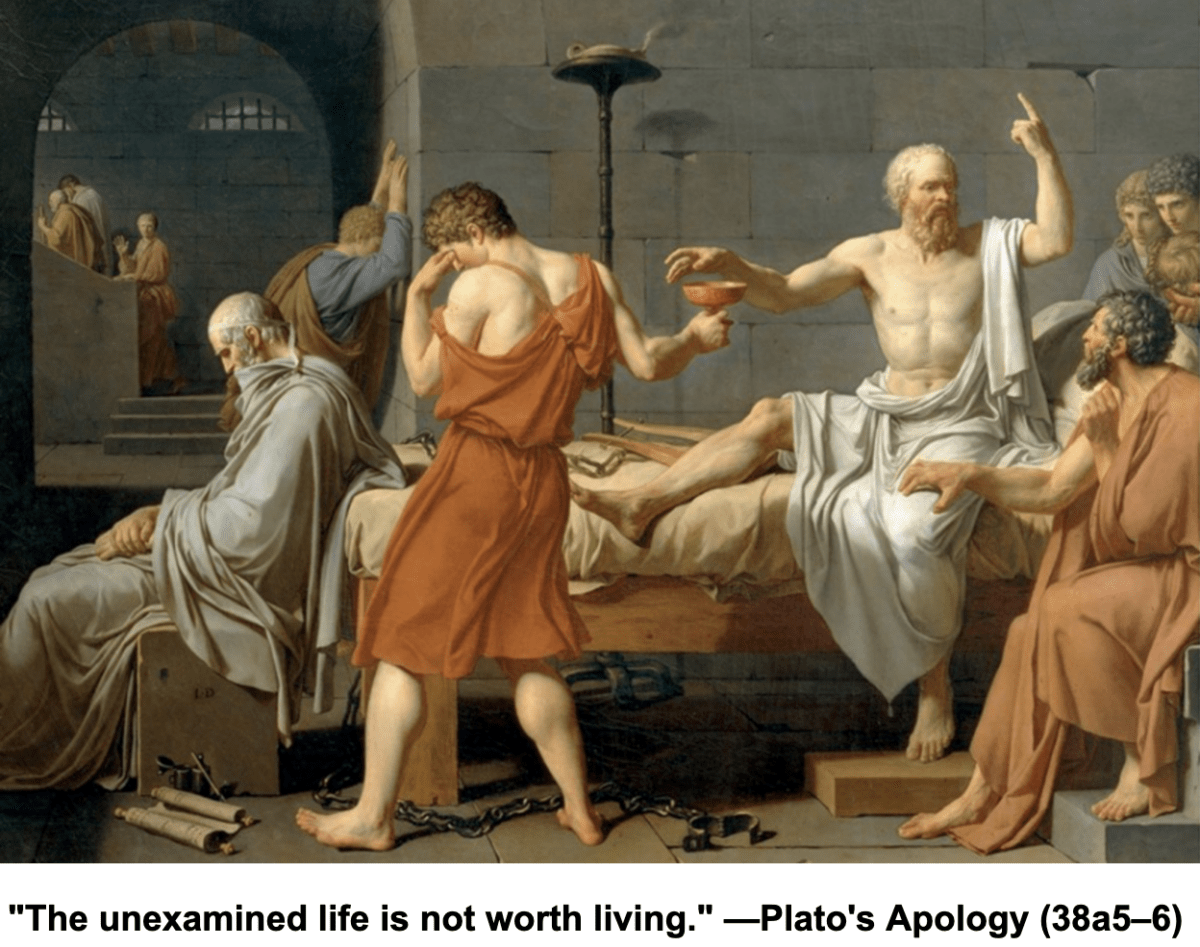
Thank you for this excellent, and timely analysis. We desperately need to learn and re-learn this slant in the historical treatment of this portion of our world population.
Eric
Have you read ‘A Stranger in Jerusalem’, Trevan Hatch?
Oh, and have been following Bari Weiss recently and also The Free Press.
MM
Absolutely Fascinating. It is always a challenge to separate true history from historiography. Even when you are present at an event so much depends upon the eye of the beholder. Thanks for the interesting insights and new ways to look at things.
Raymond, I agree with you 100% about our need to re-orient our thinking. Sadly, erroneous doctrines and beliefs taught for generations cannot be reversed overnight. And a necessary first step is an admission by the leaders of the Mormon Church that the Jewish people bear no collective responsibility whatsoever for the death of Christ. The Romans are the ones who crucified the Savior—a punishment they reserved exclusively for insurrectionists, which is exactly how they perceived Jesus.
I remember hearing all these myths and more throughout childhood; but when I delved into history they dissipated one by one. I had to learn just because something is passed down or widely accepted does not make it valid. Context is everything. So grateful to have increasing access to research these days!
Michael, thanks so much for the book recommendation. I was not familiar with Hatch’s work on this subject. His text looks quite interesting.
And, as you surmised, I too am a fan of Bari Weiss. We desperately need more journalists of her ilk.
Great hearing from you, as always.
Myths, particularly those of the religious variety, die a very slow death, Tina, as you have already discovered. We are truly blessed to be living in the golden age of biblical scholarship. The insights and discoveries, especially of the archeological variety, over the past 70 years have been spectacular. It’s a shame so many people fail acknowledge this and take advantage of it.
What I all-too-often forget to mention is that the vast majority of biblical scholars are believing Jews or Christians. These are not atheists trying to debunk the scriptures. Rather, their goal is to persuade people to take the scriptures seriously, to accept them on their own terms. Sadly, their work is often ignored, and sometimes disparaged, by fundamentalists—of both the Mormon and non-Mormon variety.
Karen, thanks as always for taking the time to read my stuff. Your opinion matters more than most, given your education and background.